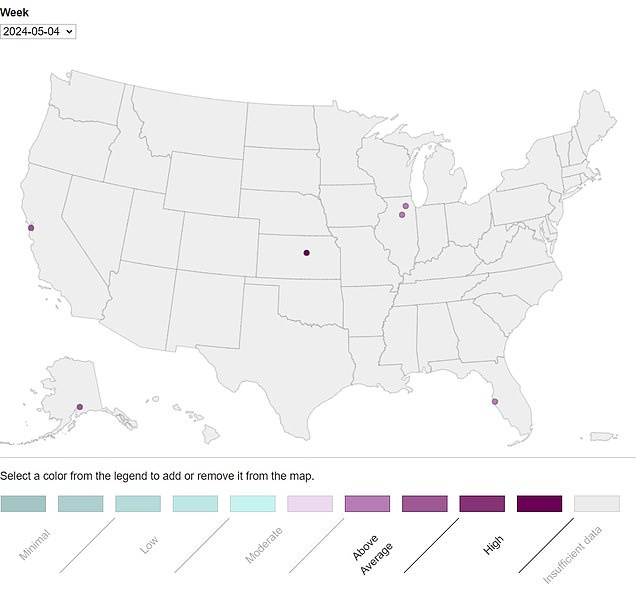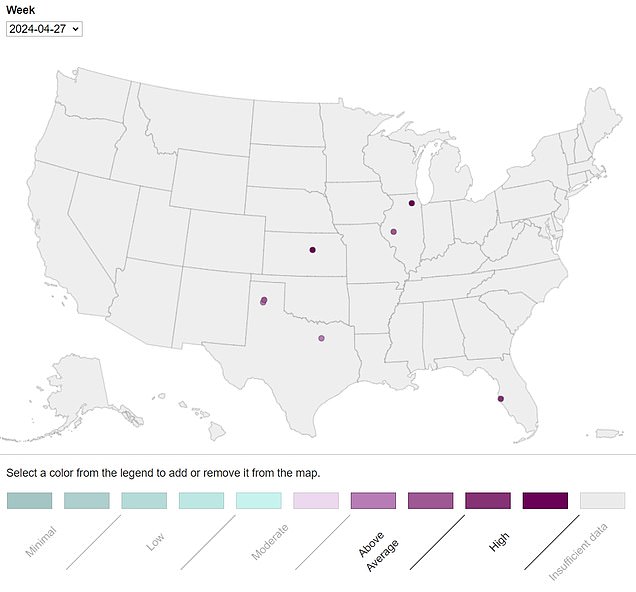Is bird flu spreading in YOUR state? CDC is launching a new dashboard so you can track where H5N1 is rising in wastewater
The CDC today launched a new dashboard that can reveal whether bird flu is spreading in your region.
The dashboard is based on wastewater samples that test positive for A-type influenza viruses, such as the H5N1 strain that infects cattle on U.S. dairy farms.
The data is presented in map form and compares positive tests to the same time last year to look for increases. Scientists say the increases do not necessarily mean bird flu has spread to humans, as type A flu is “common” in humans and accounts for about 75 percent of all cases.
But it is hoped that in the coming months the dashboard will indicate where H5N1 is most prevalent, as seasonal flu levels are normally low at this time of year.
The dashboard map above shows locations where wastewater was tested for influenza A viruses over the past week, through May 4. High levels were reported in Kansas, where livestock have also tested positive for the virus
The maps above show the locations that reported high flu levels over the past two weeks (where data is available).
For example, during the two weeks data was available, one location in Kansas — a state recording an outbreak of the virus in livestock — showed increases.
Illinois and Florida are the other states where influenza A is common.
Both states are not recording increases in flu levels overall, although increases have been seen in certain counties.
Experts say sudden surges in local areas could be linked to late-season outbreaks or unusually cold weather, which could cause people to spend more time indoors – where the flu is more likely to spread.
It could also be caused by more testing compared to the same period last year, they suggest, leading to more cases being detected.
CDC officials say the dashboard cannot determine where the virus in wastewater comes from, because it could have come from people, animals or products such as infected milk.
But the agency says tests will be conducted when increases are detected to determine if H5N1 is involved.
It comes after reports from vets that a number of farmers on farms with infected livestock were sick but did not come forward for tests.
Officials have also revealed they have had difficulty encouraging farmers to get tested for the virus – amid fears it could impact their farms.

There are concerns that bird flu viruses could spread from livestock to humans (stock)
Last week, the USDA said it would pay farms $28,000 each to allow officials on the ground to test livestock for bird flu, in an effort to encourage more people to come forward.
Amy Kirby, head of the CDC wastewater team, shared STAT that the tests were also ordered after some sites detected unusual increases in the number of A-family flu viruses.
The increases were very location-specific, she said, calling them a “very limited phenomenon.”
Officials are testing for influenza A viruses, a family of flu viruses that can infect both humans and animals. Others in this group include swine flu, or H1N1, and a type that can circulate in dogs and humans, or H3N2.
They differ from influenza B viruses, a family of these viruses that can only circulate between humans.
The latest map, for the week of April 30 to May 4, shows that one location in Kansas had higher than normal levels of influenza A viruses.
Over the past week, three locations, including one in Florida and another in Illinois, also reported spikes — though neither detected the virus in livestock.
The disease was also seen at higher than average levels in parts of Texas this past week, including the Texas Panhandle – where infected cattle are located.
A total of 674 locations are included on the map, although only 230 reported wastewater data in the past week.
It comes amid the cattle outbreak that has so far sickened 42 herds in more than nine states.
However, some experts fear this is an underestimate because many farmers refuse to have their animals tested.


